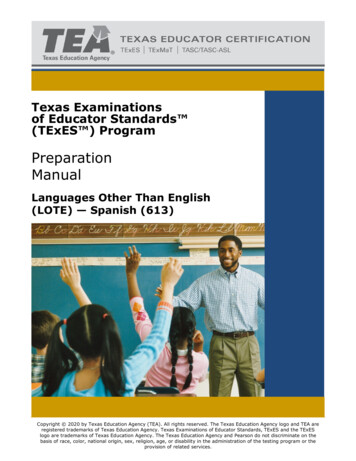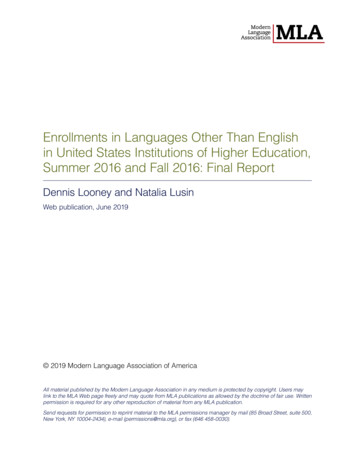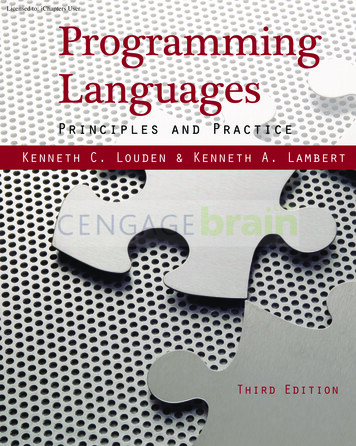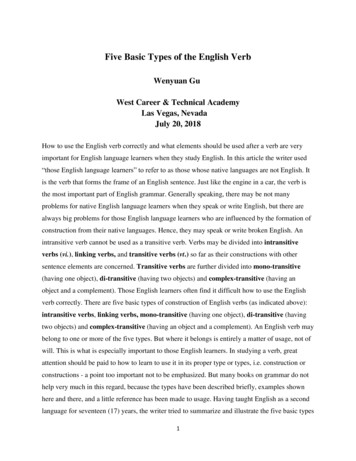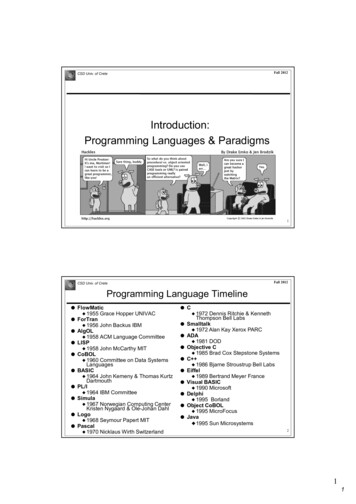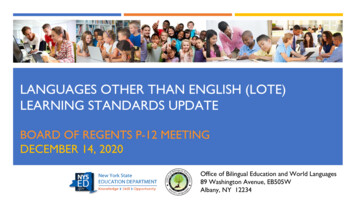
Transcription
LANGUAGES OTHER THAN ENGLISH (LOTE)LEARNING STANDARDS UPDATEBOARD OF REGENTS P-12 MEETINGDECEMBER 14, 2020Office of Bilingual Education and World Languages89 Washington Avenue, EB505WAlbany, NY 12234
CURRENT STANDARDS REVIEWOver the past 3 years, NYSED engaged New York State educators in thereview and development of revised P-12 NYS Languages Other Than English(LOTE) Standards:Included classroom teachers, administrators, higher educationrepresentatives, and other stakeholders.Used the National World-Readiness Standards for Learning Languages andthe previously approved NYS Modern Languages for CommunicationStandards (1986, 1996) as the foundation for the review.The result is the proposed revision to the New York State Languages OtherThan English (LOTE ) Learning Standards.
HOW DOES THIS REVISION BENEFIT STUDENTS? The standards are being updated to reflectcurrent research and best practice. All New York State students deserve a “well-rounded” education. Linguistic and cultural competence are critical toour students’ success in the 21st century. Multilingual proficiency creates opportunities forstudents to be highly competitive in the globaleconomy.
WHO WAS INVOLVED?Educators World languagesteachers fromelementary, middle,and high schoolsfrom the 7 regionsof NYS Higher educationfaculty BOCES/RBERNstaffAdministrators Buildingadministrators Districtcoordinators(Directors ofWorld Languagesand English as aNew Language) World LanguageLeadership Team*Acronyms are listed in the Board of Regents memoProfessionalOrganizations*Other Stakeholders NYSUT Parents NYSAFLT High school NYSAWLAstudents ALOUD College students PWRFL Pre-service teachers NYSAFLT RochesterRegional WNYFLEC COLT College Board
7 REGIONAL STANDARDS REVIEW onValleyMid-West(Finger Lakes)New York City regionNew York CityLong Island182 members from Capital-East, Hudson Valley, Long Island,New York City, Mid-State (Central), Mid-West (Finger Lakes)and Western regions!
3 LANGUAGE-SPECIFIC COMMITTEES 27 members American Sign Language Classical LanguagesWesternRegion Indigenous LanguagesMidStateRegion
KEY FEATURES OF THE PROPOSED REVISIONS TO THELOTE LEARNING STANDARDSRevisedStandards forModern &ClassicalLanguagesLOTE nder atorswith targetranges foreachCheckpoint
SHIFT #1: LOTE TO WORLD LANGUAGESWorld LanguagesModern LKoreanIndigenousLanguagesAND MORE.!Classical LanguagesLatinAncientChineseAncientTamilAncient AncientGreek HebrewAncient AncientPersian SanskritCapital-East Region
SHIFT #2: REVISIONS TO MODERN LANGUAGES STANDARDSAnchor Standard:CommunicationLearners communicate effectively in the target language in order to function ina variety of contexts and for multiple purposes.Standard 1: InterpretiveCommunicationAnchor Standard:CulturesStandard 2: InterpersonalCommunicationStandard 3: PresentationalCommunicationLearners use the target language to identify, describe, compare, and explainthe practices, products, and perspectives of the cultures studied.Standard 4: Relating Cultural Practices& Products to PerspectivesStandard 5: Cultural Comparisons
SHIFT # 3: OVERARCHING THEMES & UPDATED TOPICSThemes for Modern LanguagesIdentity & SocialRelationshipsThemes for Classical Languages Identity and Family LifeContemporary Life Physical Environment, Geography, and Travel Daily Life and Societal Institutions History, Government, and Economics Religion, Myths, and LegendsScience, Technology & theArtsGlobal Awareness &Community Engagement Literature, Architecture, and Art
SHIFT # 4: BENCHMARKED PERFORMANCE INDICATORSCheckpointTarget Performance RangeA* (7-8th, 9th)Novice Mid-HighB (9-10th)Intermediate Low-MidC (11-12th)Intermediate Mid-HighLong Island Region*Checkpoint A includes all novice learners from Pre-K through those who begin LOTEstudy in high school. The most common Checkpoint A grade levels for New York schoolsare 7th, 8th and 9th.
STAKEHOLDER SURVEY (12/16/19 – 2/1/20) 1,120 complete responses Respondents across all regions/roles Participation from public, nonpublic, charter,homeschooling, BOCES, post-secondaryHudsonValleyRegion All levels of experience 19 world languages represented 94% of respondents indicated that they eithermoderately or strongly supported the standardsoverall; however, some themes emerged as areaswhere additional revision and support would beneeded.MidWestRegion
WHAT ARE STAKEHOLDERS SAYING ABOUT THE REVISIONS?“I am pleased to seea change to alignour state standardsto those reflected atthe national level.”“I'm glad to see thestandards shiftingtoward proficiency andmeasurable goals.”“I appreciate the support thestate is giving us as thisis a massive shift in worldlanguage pedagogy.”
LOTE Standards Revision TimelineDec.20202nd presentation to the NYSBoard of Regents; vote onadoption of revisions and toconsider regulatory changefrom LOTE to World LanguagesWinter20213rd presentation to theBoard of Regents toconsider adopting theregulatory change fromLOTE to World LanguagesFeb.20211st presentation ofproposed revisions to theLOTE Standards to the NYSBoard of RegentsSummer2021Spring2021Public comment period on theregulatory change from LOTEto World LanguagesRelease of ImplementationPlan for revised standards
GUEST PRESENTERS FROM THE STANDARDS COMMITTEESDr. Joanne O’TooleProfessor, Student Teaching & edTPACoordinatorSUNY Oswego - Curriculum & InstructionPrincipal InvestigatorNYSED OBEWL Standards InitiativeMs. Rachael WolfeSeneca TeacherSalamanca HSWestern RegionMs. Evelyn BibbinsGraduate of South Jefferson HS2020 Seal of Biliteracy Awardee in 2world languages1st year student at St. Lawrence UniversityMid-State Region
QUESTIONS?
Used the National World-Readiness Standards for Learning Languages and the previously approved NYS Modern Languages for Communication Standards (1986, 1996) as the foundation for the review. The result is the proposed revision to the New York State Languages Other Than English (LOTE ) Learning Standards.
